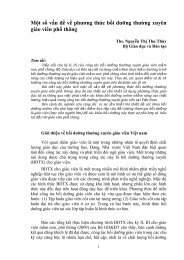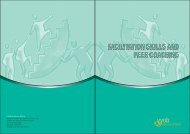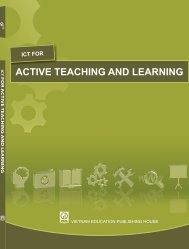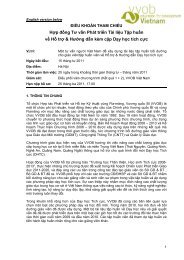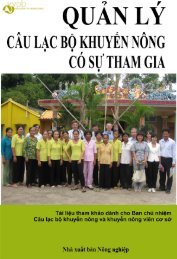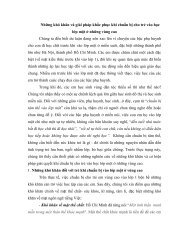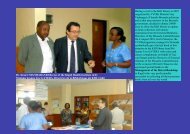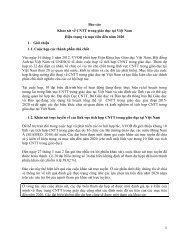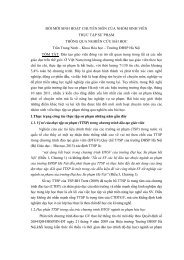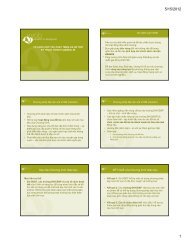Kenya Multi-Year Programme 2011-2013 - VVOB
Kenya Multi-Year Programme 2011-2013 - VVOB
Kenya Multi-Year Programme 2011-2013 - VVOB
- No tags were found...
You also want an ePaper? Increase the reach of your titles
YUMPU automatically turns print PDFs into web optimized ePapers that Google loves.
6.6. Synergy and complementarity with other actors6.6.1. General within KESSPDuring the development and the implementation of KESSP (I and II), there has been continuous (andstill is) very active consultation and harmonization between the bilateral donors and other developmentpartners, among each other and with the Education ministeries (MOE and MHEST). <strong>VVOB</strong> has beeninvolved from the early days (Februari 2005).As already explained in Chapter 4.2.6, both ministeries are responsible for developing operationalplans and budgets. Once the Government allocation (National Budget) is known, the developmentpartners are consulted to determine their level of input (and ―to fill the financing gap‖). All support tothe education sector has to be in line with KESSP. The <strong>Kenya</strong> Government does not request supportoutside KESSP.The development partners and the education ministeries have agreed to a number of ―PartnershipPrinciples‖ 19 . These principles are not tied to the financing modalities (pooled funding, directdisbursements, donations in kind...) of each partner. Nearly all development partners have now signedthis document. The principles agree on modalities of consultation, communication, monitoring andevaluation. Donors meet monthly as the ―Education Donor Consultative Group”. The ―pooling partners‖(DfiD, CIDA, World Bank, Unicef) have a separate ―Joint Financing Agreement‖ with the ministries.There is provision for the following mechanisms for consultation, evaluation and monitoring betweenthe partners:Jannual Joint Review Mission in October / NovemberAnnual Budget Workshop in March / AprilCommunication between the education ministeries and the ―Education Donor Consultative Group” ischaneled through the lead donors (Currently a ―troika‖ of CIDA, DfID, World Bank)Joint quarterly meeting with the EDCG chaired by one of the two Permanent SecretariesAdditional mechanisms depending on needs (e.g. ad hoc working groups; consultation of otherstakeholders such as unions, parents organisations... )Joint missions for identification, monitoring, audit, evaluation...A number of agreements have been made with regards to monitoring, review and conditionalities:The annual ―Joint Review of the Education Sector” (JRES) is organised by the ministries. Thedevelopment partners (DPs) participate and do not request for additional reviews. The DPs minimalisethe number of missions, reports etc and always make sure there is timely consulation with theministries and other partners. DPs aim to harmonize their own monitoring with GOK policy and thesector indicators. Since 2009, the EDCG also organizes an annual reflection day.During KESSP I (2005 – 2010), there have been cases of delayed disbursement of donor (pooled)funds (about 5% of the total education budget). The main reasons were usually insufficient or latefinancial reporting on the previous tranche. The Education Ministries continously explained theimportance of predictability of the donor support. It was in the end agreed that possible conditionalities- in case of KESSP principles were not adhered to – would be imposed during the following financialyear, avoiding disturbing the on-going budgetary cycle. Since July 2009, after a 102 million Ksh ( 1million Euro) fraud was detected, the pooling partners have put their funding on hold (until a fullforensic audit has been completed). There is however still ongoing dialogue to avoid stagnation ofKESSP, especially because the pooled funds are mainly earmarked for development (not for recurrentexpenditures). Pooling partners are also looking at alternative chanels of payment to the beneficiaries(schools).<strong>VVOB</strong>, through its agreement with the Ministry of Finance can make direct purchases. Its programmeis not affected by the witholding of funds by the pooling partners. Several other bi-lateral partnerscontinue to implement their programmes as well, using their own financial control mechanisms. There19 In line with “Paris Declaration on Aid Effectiveness” of March 2005<strong>Kenya</strong> - <strong>Multi</strong>-<strong>Year</strong> <strong>Programme</strong> <strong>2011</strong>-<strong>2013</strong> 71/148



